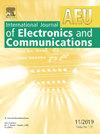Compact beam-scanning Luneburg lens antenna using transformation optics and low-cost additive manufacturing
IF 3.2
3区 计算机科学
Q2 ENGINEERING, ELECTRICAL & ELECTRONIC
Aeu-International Journal of Electronics and Communications
Pub Date : 2025-08-11
DOI:10.1016/j.aeue.2025.155969
引用次数: 0
Abstract
This paper presents the design and fabrication of a three-dimensional Luneburg lens (LL) using transformation optics (TO). A cost-effective additive manufacturing approach employing polylactic acid (PLA) material enables wideband operation. Our methodology implements an effective medium strategy through a cube-based space-filling structure, achieving precise control of the permittivity distribution derived from TO principles. The proposed lens design incorporates 2,928 unit cells, resulting in compact dimensions of . To evaluate the beam-scanning capability, an X-band WR90 waveguide serves as the feed source. The TO-based LL demonstrates a peak gain of with beam-steering ranges of and in orthogonal planes. Near-field measurements validate the simulations, showing excellent agreement between theoretical and experimental results.
采用变换光学和低成本增材制造的紧凑型波束扫描吕内堡透镜天线
本文介绍了用变换光学(TO)设计和制作三维鲁讷堡透镜(LL)的方法。采用聚乳酸(PLA)材料的具有成本效益的增材制造方法可以实现宽带操作。我们的方法通过基于立方体的空间填充结构实现了有效的介质策略,实现了基于TO原理的介电常数分布的精确控制。提出的透镜设计包含2,928个单元格,导致80mm×80mm×75mm的紧凑尺寸。为了评估波束扫描能力,采用x波段WR90波导作为馈源。基于to的LL显示出15.84dBi的峰值增益,在正交平面上的波束操纵范围为±42和±31°。近场测量结果验证了模拟结果,表明理论与实验结果非常吻合。
本文章由计算机程序翻译,如有差异,请以英文原文为准。
求助全文
约1分钟内获得全文
求助全文
来源期刊
CiteScore
6.90
自引率
18.80%
发文量
292
审稿时长
4.9 months
期刊介绍:
AEÜ is an international scientific journal which publishes both original works and invited tutorials. The journal''s scope covers all aspects of theory and design of circuits, systems and devices for electronics, signal processing, and communication, including:
signal and system theory, digital signal processing
network theory and circuit design
information theory, communication theory and techniques, modulation, source and channel coding
switching theory and techniques, communication protocols
optical communications
microwave theory and techniques, radar, sonar
antennas, wave propagation
AEÜ publishes full papers and letters with very short turn around time but a high standard review process. Review cycles are typically finished within twelve weeks by application of modern electronic communication facilities.

 求助内容:
求助内容: 应助结果提醒方式:
应助结果提醒方式:


